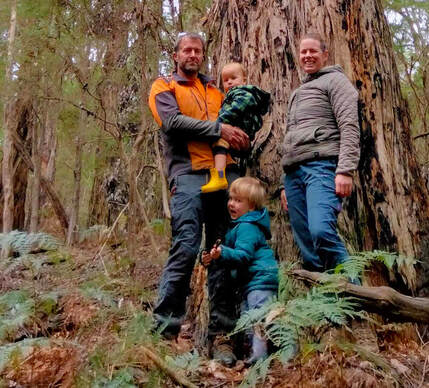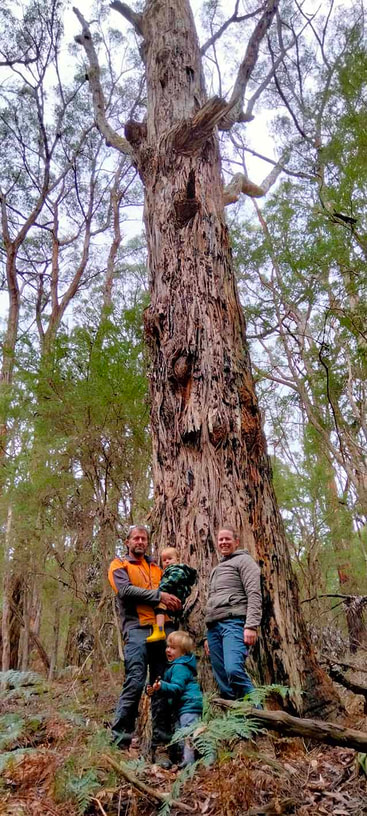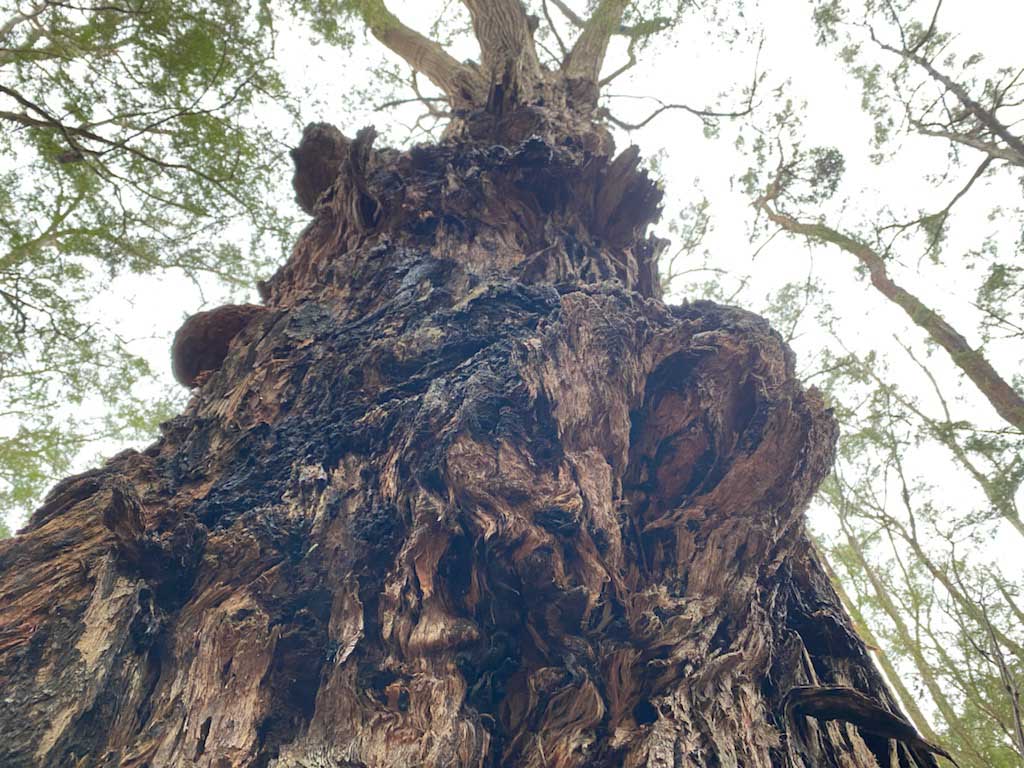 Sally McNiece goes bush with arborist Ringo Gannon and learns that
Sally McNiece goes bush with arborist Ringo Gannon and learns that when it comes to significant trees size isn’t everything.
Ringo with sons Makani and Indra, and Sally.
FOR the bloke driving past us down Stanley Road, there’s a strong chance that when he looked out the window he just saw “bush”.
Not Ringo. Pulled over on the side of the road he has us hanging out the ute windows looking intently across an expanse of Western Port Woodlands, just before Adam’s Estate. “See there, past the tree with the hollows? There with the smooth bark? It’s the last line of manna gums [Eucalyptus viminalis]. From here on you only see the shorter hybrid known as the Gippsland manna gum [Eucalyptus pryoriana].”
He meets us with his two young sons, Indra and Makani, to show us his forest. “I’m Indra! I’m three and a half!” his eldest declares, spelling his name for me (with a bit of help with the d and the a). It is very clear that these woodlands remain a family affair for the Gannons. Ringo’s dad, Mick, actively opposed the expansion of mining in the woodlands in the 1990s and Ringo is taking up the mantle today. He meets us to explain his concern for the trees throughout the estate, for the habitat they create and the greater role they play in the health of the woodland ecology.
| As you look from the family home you can see the face of the estate is changing. Some blocks have been clear felled; the only signs of the great trees that once stood are the piles of stacked firewood. Other owners have removed the understorey but left the gums and there are new compressed driveways. These actions alter the watercourse and the amount of water retained in the soil. Ringo explains that the remnant narrow leaf peppermints (Eucalyptus radiata) on multiple blocks stand naked of leaves, dying, because their feet have become too wet. It is clear the neighbours were unaware of the narrow leaf peppermint’s sensitivity. Greater education and community planning may have saved them. If this is what a driveway can do, what will a sand mine do to the neighbouring woodland and its waterways? A five-metre stump stands without branches in a neighbour’s house. Ringo laments: “I refused to cut it. This was a remnant messmate [Eucalyptus obliqua]. It was a significant habitat tree, it posed no fire risk to the house.” Arborists make their living removing trees; if they inspect a tree and turn down the job they are taking food off their own table Under state government legislation you can legally remove trees within a 10m radius of a dwelling and all lower storey vegetation to a 30m radius. But this stump stands more than 10m from the house. Some vacant blocks have been clear felled of all vegetation despite the absence of a dwelling. Bass Coast Shire Council is developing a Significant Tree Register that will come into effect early next year, but any protections have come too late for many of the old trees and the colony of Leadbeater possums that lived at Adam’s Estate when Ringo was a child. Let’s hope they found nicer lodgings in the surrounding woodlands. | Protecting significant trees Whether we are talking about Adam’s Estate, Inverloch or Wonthaggi, our significant and ancient trees are being cleared from urban settings. Formerly, under state law, you could clear your land of any vegetation, including remnant, as long as the property is under 4000 square metres (just under an acre, so almost all residential blocks) with no permit. Their only protection is the time it takes to mix petrol and oil to fill a chainsaw. Bass Coast Shire Council in the past has provided limited and inconsistent protections for remnant trees on private land. Vegetation Protection Overlays exist in parts of Inverloch, Cape Paterson, Tenby Point and the entire Phillip Island. If you wish to remove a tree of an identified species on the overlay a qualified arborist needs to identify a reason (eg disease). One of the issues is that there is an incentive for the arborist to find the tree requires removal. Protections for large trees will become uniform across the shire in early 2023 with the creation of a Significant Tree Register. Protected trees are defined as having a circumference of at least 155cm, measured 1 metre off the ground. The chances are that scraggly remnant narrow leaf peppermints, no matter how old, will be too small to be considered significant. The ability to enforce such rules will rely on the observations of the community, whether the penalty is enough to deter homeowners and would-be developers from illegally removing trees and how much an arborist needs the work that week. The council is also developing an Urban Forest Strategy which will address remnant trees. Simon Woodland, the council’s manager of sustainable environment, says remnant trees play a critical role in urban areas. “Our urban forests are one of the most cost effective, efficient, and appealing mechanisms for adapting our townships to climate change.” |
Ringo shakes his head, wishing he could answer. “You can’t tell. They’re remnant, so they have to be over 200 years. But look at what they grow on.” He scrapes his foot across the ground. “Sand, gravel … there’s no nutrients in it. They can’t grow quickly.” To emphasise his point he looks us in the eye. “There’s a painting of William Bligh landing at Two Tree Point at Bruny Island and it has two Tasmanian blue gums [Eucalyptus globulus] in it. It was painted 230 odd years ago. Those trees would have been at least 100 years old, making them over 300 years old today. I went there and found them. They’re still there, but they haven’t changed. They grow on rock, sand, gravel.”
There’s a perception that a tree’s age and value can be measured by its size. Some of these small, unassuming trees, though many decades old, are no bigger than some of the reveg trees I planted seven years ago in Inverloch. This deception does the trees no favours. Imagine how long it will take to replace their hollows.
Ringo was away from Victoria when Adam’s Estate came under threat in the Grantville fire of 2019 but watched live footage as his mum, Jan, defended the family home. It was only the intervention of the CFA and bombing helicopters that stopped the fire as it approached the back of the property. But Ringo is adamant that large remnant trees still have a place in the estate. He believes they pose a minimal fire risk to dwellings as long as canopies are not connected and are not within the 10m radius of the dwelling.

We walk along the firebreak, which rolls down the hillside towards the banks of the Bass River approximately 200 metres away. Any ground water in the mine would eventually reach the river. We take a short walk off the fire break into the forest, past a small stand of uniform melaleuca and bracken, turkey tail fungi and young ferns. There before us stands the largest tree I have seen in our area.
Affectionately called ‘Old Grumpy’ by Ringo and his boys, this messmate certainly deserves a name. Giving you an estimated height and girth won’t help you to determine its age or its value. Its bark is gnarled and covered in burls. It was whispered to in the BoonWurrung language. It was present when settlers clear felled the mountains to the south of their blue gum forests and the rainforest of the Bass River. But it still stands. This tree pollinates hundreds if not thousands of others and has the potential to seed a new forest in the ashes of those already lost.
I ask Ringo if he always wanted to be an arborist. He says he only chose it to satisfy his parents’ demands that he should choose a trade, a direction in life, but the more he learned the more he wanted to know. Now his knowledge and love of trees and the woodlands have entwined themselves into his identity, consciously or not.
His life has been shaped by growing up surrounded by Western Port Woodlands. I can only hope it will provide just as richly for Indra and Makani as it has for Ringo.
